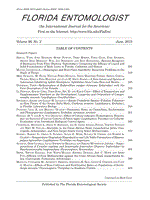The redescription of Zodariellum sungar (Jocqué, 1991), on the basis of newly collected material is provided. The female of this species, previously unknown, is described here for the first time. In addition, one new combination is established, Zodarion sungar (Jocqué, 1991) comb. n., ex Zodariellum. According to the palp and epigyne structure, the new combination clearly belongs to the lutipes group of genus Zodarion Walckenaer, 1826 and is distinguished from the other members of lutipes group by the brush hook shaped median apophysis on the male palp and by the 6 coils of the female spermathecae.
Zodariidae is a medium-sized family of spiders distinguished by their long anterior spinnerets on a common base, and other reduced spinnerets. This family includes more than 970 species in 76 genera, with a worldwide distribution, but is most abundant in tropical and subtropical regions. Zodariellum Andreeva & Tyschchenko 1968 is a small genus of ant-eating spiders of the subfamily Zodariinae, including 22 previously described species from Asia and Africa (Platnick 2013). The ant eating spider Zodariellum sungar (Jocqué, 1991) is only known by the male and the description was never provided in any other taxonomical publication (Platnick 2013). The present paper is devoted to the first description of the female and the redescription of the male of Z. sungar (Jocqué, 1991) and the new combination of the species to the genus Zodarion Walckenaer, 1826.
MATERIALS AND METHODS
Specimens were collected during the day by hand aspirator from under stones and are deposited in the collection of the Arachnological Museum of Kırıkkale University (KUAM). Pictures were taken, using a Leica S8APO microscope by means of a Leica DC 160 camera, in dishes of different sizes with paraffin on the bottom. Different size holes were made in the paraffin to keep specimens in the right position. Images were montaged using “Combine-ZM” image stacking software and “Photoshop CS5” image editing software. SEM microphotographs were made with a JEOL JSM-5600 at the University of Kırıkkale. All the specimens are preserved in 70% ethanol. Measurements are given in millimeters. Epigynes were drawn in the natural and the cleared state (after immersion in 10% KOH for 12–48 hours at room temperature). Leg measurements are shown as: total length (femur, patella, tibia, metatarsus, tarsus); measurements of leg segments were taken from the dorsal side.
Morphological Terms
Cyb, cymbium; E, embolus; Fd, fertilization duct; Id, insemination duct; Ma, median apophysis; Mp, median plate; Se, septum; Rs, receptaculum (spermatheca); Rta, Retrolateral tibial apophysis; T, tegulum; Wi, window (abbreviations adapted from Kovblyuk, 2003 and Marusik & Fet 2009).
Material Examined
Zodariellum sungar (Jocqué, 1991) (Figs. 1–4)
1♂, 1♀, Gaziantep Province, Sinanköy Village, N 37° 2′ 16″ E 37° 35′ 58″, elev. 965 m, 4-V-2012; 1♂, Gaziantep Province, Karkamış District, Gürçay Village, N 37° 2′ 16″ E 37° 35′ 58″, elev. 380 m, 5-V-2012; 2♂, 1♀, Şanlıurfa Province, Suruç District, N 37° 2′ 49″ E 38° 28′ 15″ E, Elev. 610 m; 5-V-2012.
Description
Male. Total length 4.7, Carapace 2.4 long — 1.9 wide, Abdomen 2.3 long — 1.6 wide. Pattern distinct, carapace dark brown, without band or stripe. Abdomen blackish gray, with u-shaped vertical stripes from sides. Legs dark yellow, except for femur. Leg formula IV, I, II, III. Leg measurements (n = 4): I 10.7 (2.7, 0.7, 2.6, 3.1, 1.6), II 9.9 (2.6, 0.6, 2.2, 3, 1.5), III 9.7 (2.7, 0.7, 2.1, 3, 1.2), IV 11.9 (3.4, 0.7, 3, 3.9, 0.9). Median apophysis large, brush hook shaped, denticulated at bottom, upper part strongly developed. Cymbium with retrolateral crest. Tibial apophysis short, with three protruding apophysis. Embolus very long, originating at baso-lateral side of tegulum. Palp as in Figs. 5–6, 7–9 and 10–12.
Female. Total length 4.9, Carapace 2.1 long — 1.6 wide, Abdomen 2.8 long — 1.9 wide. Pattern distinct, almost same as male. Legs dark yellow, except for femur. Femur dark brown. Leg formula IV, I, II, III. Leg measurements (n = 2): I 6.4 (1.7, 0.5, 1.4, 1.8, 1), II 5.7 (1.3, 0.5, 1.2, 1.7, 1), III 5.2 (1.7, 0.5, 0.8, 1.3, 0.9), IV 7.9 (2.2, 0.7, 1.9, 2.3, 0.8). Epigyne as in Figs. 13–15 and 16–17, with distinct window, median plate slightly protruding, mid part of epigyne with ???-shaped sclerotisation, receptacula tubule shaped, diameter equal to that of half of window. Septum thin, insemination duct very long, making 6 coils around receptacula. Fertilization duct small, digitiform.
DISCUSSION
With this paper, Zodariellum sungar (Jocqué, 1991) is reported from Turkey for the first time (Bayram et al. 2012). According to the palp and epigyne conformation, this species clearly belongs to the genus Zodarion Walckenaer, 1826. Zodarion sungar (Jocqué, 1991) comb. nov. belongs to the lutipes group because of the very long embolus originating at baso-lateral side of the tegulum and strongly coiled spermathecae. The lutipes group contains Z. christae Bosmans, 2009, Z. deltshevi Bosmans, 2009, Z. frenatum Simon, 1884, Z. lutipes (O. P.-Cambridge, 1872) and Z. samos Bosmans, 2009 (Bosmans, 2009). The new combination is clearly distinguished from all other members of the lutipes group by the very large and brush hook shaped median apophysis on the male palp and by the 6 coils of the female spermathecae. Z. sungar comb. nov. resembles Z. luctuosum (O. P.-Cambridge, 1872) and Z. nitidum (Audouin, 1826), but can be distinguished by the shape of the median and tibial apophysis of the male pedipalp and by the form of the epigyne and spermathecae.
Figs. 10–12.
SEM micrographs of male palp of Zodariellum sungar (Jocqué, 1991), 10. ventral view; 11. retrolateral view, and 12. retrolateral tibial apophysis.

ACKNOWLEDGMENTS
I am very grateful to Stano Pekár (Czech Republic) and Robert Bosmans (Belgium) for their valuable contributions. Furthermore, I wish to thank Kırıkkale University Scientific and Technological Research Laboratories (KUBTAL) for use of the SEM. Last but not least, I want to thank reviewers for their valuable comments.










